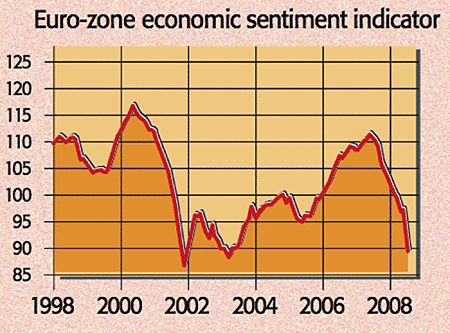
Earlier this year the eurozone’s prospects appeared “less dim than for some other parts of the rich world”, said The Economist. High oil and scant credit seemed a greater threat to “gas-guzzling, debt-ridden” Americans rather than “high-saving, fuel-efficient” continental Europe. Yet it looks as though the eurozone will be the first major economy to slip into recession, with negative growth in the second and third quarter.
There has been a “remarkable unravelling” in the data of late, as Matt Sharatt of Bank of America put it. A region-wide gauge of both consumer and business confidence, the economic sentiment index, fell sharply to a five-year low across the zone in July, while a closely-monitored activity index combining services and manufacturing slid to a seven-year low. Retail sales slid by 0.8% in the second quarter after a 0.2% drop in the first, as credit tightened and high inflation dented incomes and confidence. In Spain, retail sales are down 7.7% on last year in the wake of the housing bust. Morgan Stanley now sees a 40% chance of a Spanish recession as severe as the early 1990s slump after the ERM debacle, which would plunge Spain’s property-exposed banks into a “crisis scenario”. And officials say Germany’s GDP shrank by around 1% in the second quarter.
What next?
The global slowdown and expensive euro have dented exports, and consumers remain cautious, while a more recent problem appears to be corporate spending. Firms once able and willing to borrow to invest are retrenching, notes The Economist. Given the overall eurozone’s lack of imbalances a nasty US/UK-style housing and consumer slump isn’t on the horizon, reckoned Capital Economics. But now the eurozone seems unlikely to outgrow its major competitors in 2008.